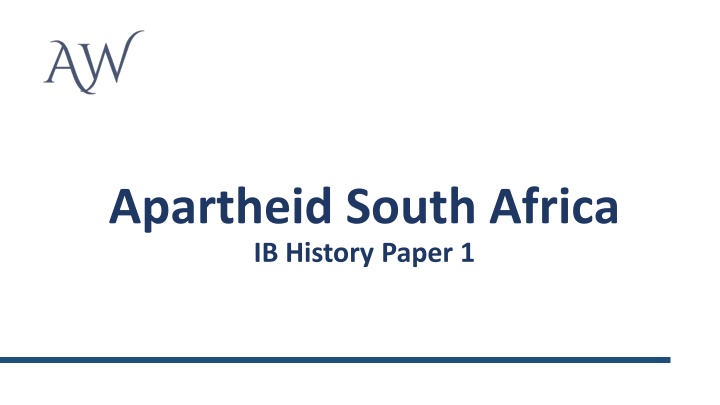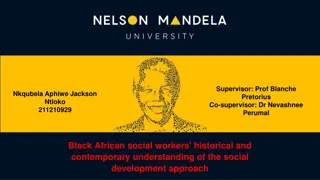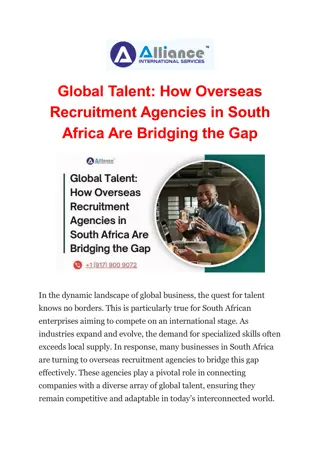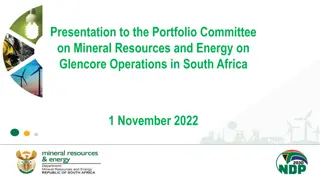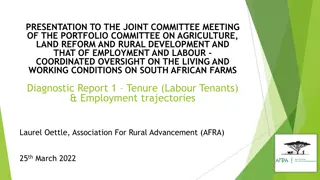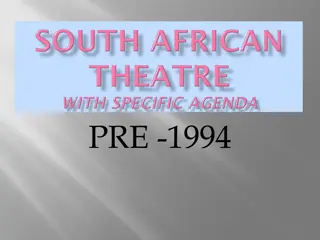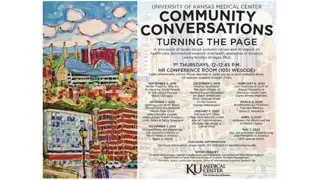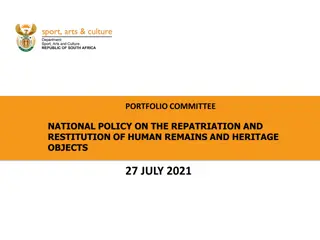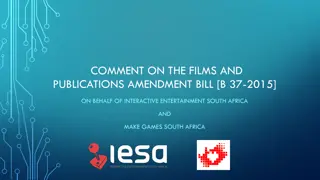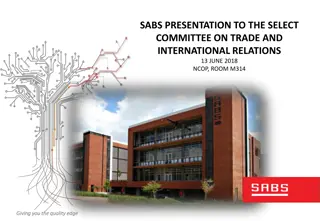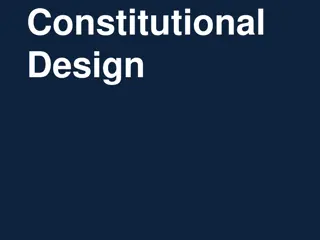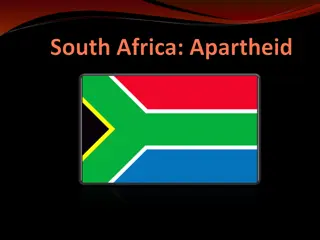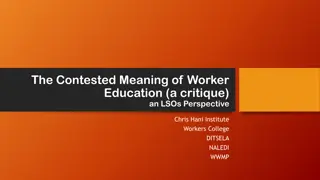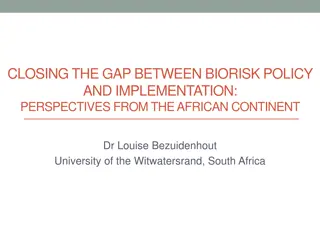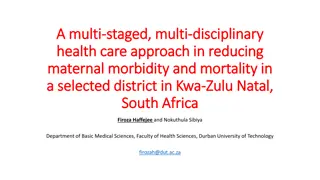Apartheid South Africa
The roots of apartheid in South Africa from early segregation measures imposed on Xhosa people to the discriminatory policies of restricting land ownership and enforcing racial segregation laws. Learn about the political landscape that paved the way for the implementation of apartheid under different South African parties.
Download Presentation

Please find below an Image/Link to download the presentation.
The content on the website is provided AS IS for your information and personal use only. It may not be sold, licensed, or shared on other websites without obtaining consent from the author.If you encounter any issues during the download, it is possible that the publisher has removed the file from their server.
You are allowed to download the files provided on this website for personal or commercial use, subject to the condition that they are used lawfully. All files are the property of their respective owners.
The content on the website is provided AS IS for your information and personal use only. It may not be sold, licensed, or shared on other websites without obtaining consent from the author.
E N D
Presentation Transcript
Apartheid South Africa IB History Paper 1
What do I need to know? 1948 victory of the National Party to 1964 imprisonment of Mandela You may want to know earlier for context
What is apartheid? Stems from a system of othering inherent difference Natural hierarchy due to the cultural achievements of the White race Apartheid vision states that the government should recognise these hierarchies and promote them in policy Social Darwinist philosophies of C20th Europe
Causes of apartheid Calvinist scripture God created two races, therefore Character of early British rule in the Cape not paternalistic and liberal. Settlements on eastern frontier Frequent contact with Xhosa was frequent due to travel for work 1853 constitution of Cape Colony civilised v. uncivilised
Early segregation Xhosa people became subject to punitive laws such as having to carry ID regulated Black movement, limit employment Connection between economics and segregation Curfew to prevent Blacks in White area at night 1886 discovery of gold on Witwatersrand and emergence of Johannesburg 1890s more rigid segregation with expansion of Cape Town fear of racial swamping and deterioration in sanitation 1901 Bubonic plague led to establishment of Ndabeni
Early segregation contd Act of Union restricted voting to Whites Mines and Works Act 1911 semi-skilled positions for Whites Natives Land Act 1913 limited land that Africans could own or rent. 2/3 of population limited to 7.5% of country Natives Urban Areas Act 1923 cities principally for use of White population. Blacks to carry pass Industrial Conciliation Act 1924 Whites join trade union Wage Act 1925 preference for Whites in hiring Mines and Works Amendment Act 1926 mining industry
Politics South African Party Louis Botha and Jan Smuts 1924 NP coalition JBM Hertzog more ambitious 1934 merger of Hertzog s NP and Smuts SAP to create United Party Malan s breakaway party GNP (Gesulwerde Nasional Party) threatened to outflank UP leading to more discriminatory laws
Early segregation contd Representation of Natives Act 1936 remove Africans from electoral roll in the Cape Native Trust and Land Act 1936 area of natives reserve to 13% Native Laws Amendment Act 1937 stricter enforcement
Politics End of 1930s saw increase in Afrikaner nationalist spirit leading to Afrikaner Broederbond being formed worked with NP GNP and Afrikaner Broederbond supported by most poor Afrikaners who felt alienated by elitist UP South Africa entered WW2 on side of allied Hertzog resigned because Smuts supported war. Smuts government undermined because Africans supported Nazis Hertzog reconciled with Malan and they became new National Party
Politics African Mine Workers Union organised a strike of nearly 100,000 people in 1946 alerting Smuts government to urgency of labour crisis Fagan Commission set up said that the tide of African urbanisation was irreversible and should normalise status of Blacks near cities. Recommended to relax pass laws. Fagan Report formed basis for UP s policy manifesto for 1948 General Election heightened racial anxieties NP reacted with Sauer Commission country s survival depended on promotion of White race
1948 election Malan s National Party won Immediately issued a spate of laws that became foundation of apartheid Apartheid could be argued an extension of early segregation
Petty vs Grand PETTY was earlier section associated with NP rule of Malan and Strijdom. Political and economic domination of Blacks. Brutal subjugation of Black majority and the decisive manner with which the government dealt with anti-apartheid opposition GRAND was later section initiated by HF Verwoerd in late 1950s. More ideologically sophisticated. Aimed at complete territorial segregation of South Africa and ultimate independence of each part. Moral legitimacy?
Apartheid Prime Ministers Daniel Francois Malan 1948 1954 Founded NP in 1914 Founded GNP in 1934 Became Prime Minister in 1948 Johanned Gerhardus Strijdom 1954 1958 Lion of the North dominated NP in the Transvaal Part of Malanite split to found GNP Radical and uncompromising Dr Hendrik Frensch Verwoerd 1958 1966 From Holland, brilliant scholar Known as architect of apartheid
Population Registration Act 1950 Classified entire nation by race One of first laws to be passed by NP government Classified by biology not community Code put in ID number Split population into 3: White, Coloured, Bantu Implemented with astonishing vigour Race Classification Board established Members of public could report people Tests included: linguistic proficiency, skull, pencil Social stigma abandon babies
Prohibition of Mixed Marriages Act 1949 Miscegenation Children born of mixed marriage couldn t be White Promote separation of races Made mixed marriages illegal even though in the 3 years prior there were only 75 recorded examples
Immorality Act 1950 Banned all extra-marital sexual relations between Whites and other races Police would react to a tip off and burst in in the middle of the night hoping to catch people in the act Fines and prison terms
Reservation of Separate Amenities Act 1953 Strict segregation of all public amenities Public services such as buses, trains, toilets, hospitals were separated before apartheid Separate entrances and service counters in shops/post offices Separate waiting rooms Platforms at train stations Parks, beaches, swimming pools, public benches, water fountains, hotels and restaurants in city centre Symbolised dramatic decline in status of Blacks
Group Areas Act 1950 City centres for White residence only Malan called it the essence of apartheid of coloured people forced to move Before 1955 this act was used to target coloured and Indians
Pass Laws Act 1952 Replaced existing passbooks with more comprehensive documents. 96 page booklets that contained information about employment, criminal records, tax payments, etc. Introduced with complicated permit system built in which allowed Blacks into certain areas for fixed periods Any White person could demand to see a Black person s pass Many of the most-effective anti-government demonstrations used the Pass Laws Act as a means of protest ANC s Defiance Campaign of 1952 was launched in the wake of the passing of the act
Sharpeville Massacre - RESISTANCE Mass action which led to the Sharpeville massacre required protesters (5000-7000) to present themselves at police stations without their reference books 21 March 1960 South African Police opened fire on the crowd killing 69 289 casualties total including 29 children Chied Luthuli (ANC leader) burned his reference book in a powerful act of protest after the massacre
Natives Resettlement Act 1954 Group Areas Development Act 1955 Permitted authorities to remove Blacks forcibly from Johannesburg Creation of the Natives Resettlement Board Meant that authorities could focus on Sophiatown In 1955, 65000 residents were forcibly relocated and the city was razed to the ground Replaced with Afrikaner suburb of Triomf Sprawling resettlement areas dominated SA s urban landscape by 1950s, thousands of squatters outside these too Largest town was Soweto with population of 2million Tsotsis urban gangsters
Native Laws Amendment Act 1952 Blacks could only stay in city if they had been born there and employed there and employed there for more than 15 years (or 10 of continuous employment) Immediate exclusion of young Africans Except Black women in domestic servitude but not their families
Bantu Education Act 1953 Schools were only allowed to admit children from one racial group only. Education of Africans now under control of Native Affairs Department headed by HF Verwoerd (but Ministry of Education in charge of others) Further than separate schools, this dispensed of the idea of a single educational model. Each school board had a different curriculum tailored to the believed intellectual capacity and practical requirements of each racial group No academic content Basic literacy and numeracy Technical skills for domestic service Unskilled labour for mining or manufacturing
Bantu Education Act 1953 contd Black children to attend school in 3 hour shifts No books or other essential equipment teachers and students would often write in the ground with sticks Ratio of spending on White : Black students was 7:1 Huge difference in salaries for Black/White teachers Nearly 85% of all Black teachers had no professional qualification Many parents just took their children out of school Attempts were made in Bantu education to foster a stronger sense of tribal identity
School boycott - RESISTANCE Following the Bantu Education Act, the ANC announced a permanent boycott of the new system (despite not being able to provide an alternative). Began April 1955 Verwoerd threatened to close any school that supported the boycott and to permanently any student who didn t attend ultimately parents were scared of taking part Nonetheless it was a partial success because Verwoerd was sufficiently rattled to tone down the new syllabus emphasis on tribalism
Steve Biko Became involved with Poqo Biko was a powerful critic of Bantu education and argued that it was a means of dehumanising Blacks Black Consciousness Movement Black is beautiful SASO formed on the basis of Biko s Black Conciousness Movement Despite Biko s efforts many young people lost hope and turned to crime. Whole communities were condemned to permanent impoverishment
The Extension of University Education Act 1959 Extended apartheid principles to tertiary education All universities required to admit students from only one racial group or in the case of African universities, a single tribe This furthered Verwoerd s policy of pursuing entirely separate population groups with their own separate educational facilities to create self-contained political and economic units for each This led to an outcry in the academic community and many lecturers resigned in protest
Bantustan System Also known as the homelands system Transform existing nature reserves into a number of small, fully independent states. Over time, Blacks would be expected to live in these homelands and they would become a citizen of one of the Bantustans instead of South Africa which would become an exclusively White country First Bantustan to be created was Transkei Transkei Constitution Act passed in 1963
Bantu Authorities Act 1951 Passed by Malan government Created new regional authorities for Africans, based in the reserves Got rid of Natives Representative Council which represented all Africans
Promotion of Bantu Self-Government Act 1959 Most important law in terms of creating homeland system Passed by Verwoerd s government Divided African population into 8 distinct ethnic groups, and later 10 The members of each group were assigned a White commissioner-general whose task it was to assist them in the transformation to independently ruled in their designated area This meant that Blacks were no longer the responsibility of the government, so it abolished completely Black political representation
Promotion of Bantu Self-Government Act 1959 contd Black South Africans could vote in homeland elections In 1970, the government decreed that all Black South Africans were citizens of the homelands and not South Africa with immediate effect all Blacks living in SA and not the homelands were foreigners in their own country Homelands only became fully independent in the 1970s but most Black South Africans never felt any political allegiance to their assigned homelands
Bantu Investment Corporation Act 1959 Apartheid planners and Bantustan leaders hoped that homelands could become economically viable and encouraged businesses to relocate close to their borders to take advantage of the cheap labour These hopes were never realised though Creation of these homelands was an attempt to try and create a place where traditional African culture could be celebrated but the complete impoverishment actually led to a growing moral cesspool with casinos, cabaret and nude shows forming the only valuable industry in these cities
Other notable laws Separate Representation of Voters Act 1951 removed all Coloureds from electoral roll Stock Limitation Act compulsory for Africans to cull their cattle The Suppression of Communism Act 1950 made Communism illegal but defined Communism as anything anti-apartheid or anti-government Public Safety Act 1953 Government could declare state of emergency and suspend the constitution Criminal Law Amendment Act 1953 severe penalties for anyone breaking apartheid laws Native Administration Act 1956 could banish Africans who broke the law Customs and Excise Act and Official Secrets Act of 1956 allowed government to establish a Board of Censors that meant they could ban any media publication, book, film, or other material that they thought might upset the political, moral, or religious sensibilities of the White population
Defiance Campaign - RESISTANCE Protest organised by ANC (African National Congress) that marked opening of new more radical phase of the struggle Launched as a response to Malan s raft of laws Decisive action needed to be taken strikes had little impact and the government wouldn t engage in conversation Designed to put pressure on government to repeal legislation: Harness power of masses ANC leaders would break the law with crowds of onlookers supporting the, Philosophy for non-violent civil disobedience contrasted with heavy-handed response of the authorities aimed to put apartheid in the spotlight Fill SA s prisons to the point of overflowing. Stretch the various institutions of repression to breaking point (courts, prisons, police ) Involve South African Indian Congress in the struggle and other communities
Tercentenary of Whites in the Cape Event organised by the National Party to celebrate the tercentenary of Jan van Riebeeck s landing on the Cape in 1652 was met with Afrikaner triumph ANC organised mass rallies to coincide with this Civil disobedience was at the heart of the campaign Increasing civil disobedience was designed to work in conjunction with a series of general strikes to bring the apartheid state to its knees and negotiate with the ANC
Civil disobedience Meeting at 11pm (the time the curfew began) Singing freedom songs Burning/damaging passbooks Using segregated amenities, Whites only entrances to railway stations, post offices, etc. Illegally entering White suburbs without passes Remaining in White areas after curfew The ANC grew from 20,000 members at start of Defiance Campaign to over 100,000 by 1953
End of the Defiance Campaign The Defiance Campaign peaked in mid-1952 and by the end of the year more than 8300 had been arrested By early 1953 a riot in the Eastern Cape meant that the ANC lost momentum that it never regained. The purpose of civil disobedience was defeated as people realised how easy it was for peaceful protest to break out into violence (it also provided the authorities a reason to crush the campaign)
Was the Defiance Campaign a success? Failed to get any of the 6 laws repealed that it wanted to Government responded by putting even harsher laws in place Rural areas weren t really included in the campaign General strikes never actually happened Only really middle-class Blacks took part Very few Coloureds took part Viewed with hostility by Whites (especially after riots) English language press largely unsympathetic Whites only general election in 1953 re-elected NP
Was the Defiance Campaign a success? First extended national campaign against apartheid system Thousands of ordinary South Africans had demonstrated their readiness to support the struggle stage had been set for true mass movement Broad coalition of interest groups involved Hardly anyone in the party had openly opposed the campaign National and global profile of ANC grew enormously Revealed the brutality and moral bankruptcy of the apartheid system to the global community In 1953, the UN established a Commission on the Racial Situation in the Union of South Africa
Congress of the People COP convened in 1955 as an alliance of anti-apartheid congress movements of which the ANC was the largest The COP would recruit thousands of volunteers to bring COP to the masses and involve as many ordinary Africans as possible in its actions (including drafting the FC) Purpose of COP was to: Unite all groups in the fight against apartheid Expand membership (especially of poorer Africans) Work with other parties and other groups including the Coloureds Draft a Freedom Charter
The Freedom Charter The Freedom Charter, which was adopted by the Congress of the People in 1955, remains the basic policy document of the ANC. Intended to be a constitution for democratic, post-apartheid South Africa The Freedom Charter declares that: The people shall govern All national groups shall have equal rights The people shall share in the country`s wealth The land shall be shared among those who work it All shall be equal before the law All shall enjoy equal human rights There shall be work and security The doors of learning and culture shall be opened There shall be houses, security and comfort There shall be peace and friendship
Congress of the People Ultimately the aim of COP was to raise awareness They held a number of campaigns, rallies, conferences and gatherings that were well-attended but most were smaller Encouraged joining the ANC Million Signatures Campaign Reached a climax on 25/26 June at a mass meeting on football field in Kliptown to the south of Johannesburg that was attended by 2844 people. Leaders including Chief Luthuli, ZK Matthews, Nelson Mandela and Walter Sisulu were banned from attending. The Freedom Charter was proclaimed Kliptown rally ended in chaos as armed police raided the meeting. Police arrested delegates and seized documents. The government argued that the drafting of a new constitution was treason and launched the Treason Trial which attempted to charge the ANC leaders. Whilst the proceedings took a toll on ANC, all leaders were acquitted
Bus boycotts First major boycott in 1940 continued to be frequent during early apartheid years 1943 Nelson Mandela marched 9 miles from Alexandra into Johannesburg with tens of thousands of other protesters Boycotts in 1944, 49, and tram boycotts in 50, 54, 55 they tended to be caused by economic reasons rather than political (increase in fares from townships to the cities) Committees were formed which would negotiate with the bus companies. 1944 up to 20,000 boycotted Often successful Johannesburg Chamber of Commerce were mindful of impact on businesses and would typically intervene, persuading bus companies to reduce fares Dependence on economic forces meant that the ANC could not dictate timing of protests
Alexandra boycott Most significant boycott was the Alexandra township boycott which began in January 1957 Triggered by decision to raise fares 4p to 5p Demonstrations on unseen scale and widespread media coverage More than 20,000 people (even those whose bus routes had not been affected) joined in the protest by 15 January In total 70,000 people walked daily for 12 weeks Sense of solidarity with fitter helping elder/weaker Police would regularly stop the marches and demand to see passes or puncture bicycle tyres Alexandra People s Transport Action Committee Eventually Johannesburg Chamber of Commerce intervened Viewed as a great threat by apartheid government because it had been a spontaneous act of the people and not planned by ANC, it had also received sympathy from White media (Whites drove to Alexandra to offer lifts to Johannesburg first show of White fraternity to Blacks)
Impact of Alexandra boycott on ANC Demonstrated that the power of people could be effectively used against the government However, mass protest could be difficult to control This came to life in 1959 with the breakaway party PAC emerged and launched a campaign against the pass laws which turned out to be disastrous
Creation of the PAC A small group inside the ANC opposed their stay-at-home strategies Ironically this won the approval of the White press who noted that Sobukwe and Leballo were the respectable faces of Black politics They announced their departure from the ANC and formed the Pan Africanist Congress in 1959 PAC s strategies were to hijack some of the campaigns launched by the ANC. December 1959 ANC launched campaign against pass laws that would culminate in mass bonfire of passes. In response, PAC organised a demonstration for a few days before the ANC s
Sharpeville Massacre - RESISTANCE Mass action which led to the Sharpeville massacre required protesters (5000-7000) to present themselves at police stations without their reference books. They arrived singing freedom songs 21 March 1960 South African Police opened fire on the crowd killing 69 - dispute 289 casualties total including 29 children Chied Luthuli (ANC leader) burned his reference book in a powerful act of protest after the massacre There were additional clashes between police and protesters on the same day in Langa and elsewhere in the country Meant that the ANC abandoned strategy of peaceful protest and turned to armed resistance
State of emergency was declared Verwoerd s response to the escalating crisis was to declare a state of emergency on 30 March 1960 Thousands of ANC and PAC leaders were arrested and all political gatherings were outlawed The government banned both resistant movements on 8 April with the Unlawful Organisations Act The only viable option was for the movement to go underground and begin armed struggle Nelson Mandela (now a fugitive) convinced the ANC that they should move towards armed struggle and their armed wing Umkhonto we Sizwe was created in 1961
Why did Sharpeville result in armed struggle? Sharpeville marked a turning point in the history of the ANC since the government were prepared to use armed force against unarmed protestors ANC rivalled by PAC who had armed wing Poqo (created in aftermath of massacre) and ANC couldn t be outflanked Decision to adopt armed struggle wasn t entirely to do with massacre as there had existed internal debate for a long time within the ANC. As early as 1953, Mandela had created the M plan dissolution of central organisation and formation of small groups to launch full-scale guerrilla insurgency
Wider significance of massacre Massacre marked sea change in terms of international campaign against apartheid Harold Macmillan 1960 Winds of Change speech nationalist aspirations would have to be met eventually Country s international isolation began with economic sanctions being put in place (though major trading partners Britain and USA would not take part in global embargo) SA forced out of British Commonwealth becoming a republic in 1961
